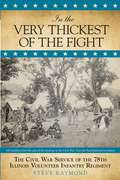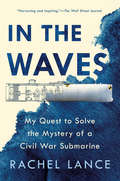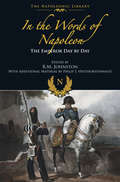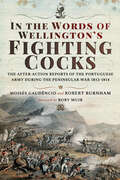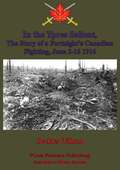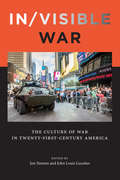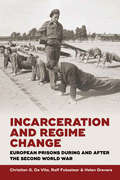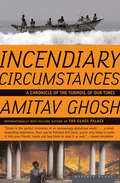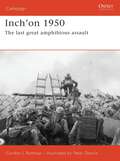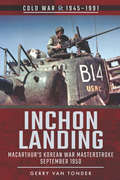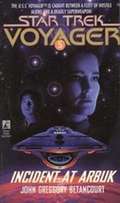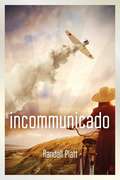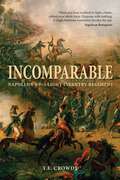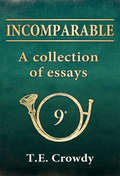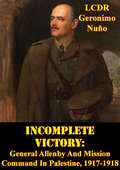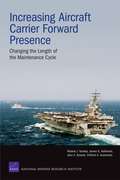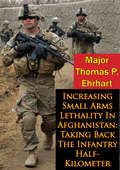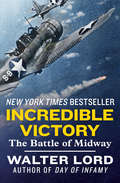- Table View
- List View
In the Very Thickest of the Fight: The Civil War Service of the 78th Illinois Volunteer Infantry Regiment
by Steve RaymondThe 78th Illinois Volunteer Infantry Regiment took the field under command of a lackadaisical colonel who was frequently absent and feuded with his own officers and superiors. Distrusted by senior officers, the 78th became a regiment that was always left behind—until its own officers forced their reluctant colonel to resign. His replacement was a forceful leader who turned the regiment into a crack fighting outfit that performed heroically in the battle of Chickamauga and many of the great battles of the Atlanta campaign. It later joined Sherman&’s March to the Sea and fought its way out of the tangled swamps of Bentonville in one of the war&’s last battles. Its story is told here mostly in the words of its soldiers through letters, diaries and other sources, many never before accessed by historians. This book sheds new light on many important incidents and battles in the Civil War&’s Western Theater.
In the Wars: An uplifting, life-enhancing autobiography, a poignant story of the power of resilience
by Dr Waheed ArianAS HEARD ON DESERT ISLAND DISCSAS SEEN ON THE CHANGEMAKERS, a Paramount+ docuseries profiling activists fighting for changeA WATERSTONES PAPERBACK OF THE YEAR'A riveting story of loss, exile, and rebirth.' KHALED HOSSEINI, author of The Kite Runner'One of the most incredible life stories you will ever hear.' JAMES O'BRIEN'A remarkable story. I thought this book was brilliant.' NAGA MUNCHETTY__________Born in war-torn Afghanistan, Waheed Arian's first memories are of bombs. His first-hand experience of the power of medicine inspired him to dedicate his life to healing others. But how does a boy with nothing hope to become a doctor?Fleeing the conflict with his family, he spent much of his childhood in refugee camps in Pakistan, living sometimes ten to a room without basic sanitation or access to education. Waheed largely taught himself, from textbooks bought from street-sellers, and learned English from the BBC World Service.Smuggled to the UK at fifteen with just a hundred dollars in his pocket, he found a job in a shop. He was advised to set his sights on becoming a taxi driver. But the boy from Kabul had bigger ambitions.Working through PTSD and anxiety, he studied all hours to achieve his vocation. He was accepted to read medicine at Cambridge University, Imperial College and Harvard, and went on to become a doctor in the NHS, currently in A&E.But he wanted to do more. In 2015 he founded Arian Teleheal, a pioneering global charity that connects doctors in war zones and low-resource countries with their counterparts in the US, UK, Europe and Australia. Together, learning from each other, they save and change lives - the lives of millions of people just like Waheed.For readers of Educated and War Doctor, this is the extraordinary memoir of a boy who recognized the power of education and dreamed about helping others. It is a tale of courage, ambition and unwavering resilience in the face of all the challenges that life can throw in your way.__________WINNER OF:UNESCO's Global Hero AwardWho Cares Wins Best Doctor AwardThe Times's Man of the Year Award
In the Waves: My Quest to Solve the Mystery of a Civil War Submarine
by Rachel LanceOne of "The Most Fascinating Books WIRED Read in 2020""One part science book, one part historical narrative, one part memoir . . . harrowing and inspiring.&”—The Wall Street Journal How a determined scientist cracked the case of the first successful—and disastrous—submarine attack On the night of February 17, 1864, the tiny Confederate submarine HL Hunley made its way toward the USS Housatonic just outside Charleston harbor. Within a matter of hours, the Union ship&’s stern was blown open in a spray of wood planks. The explosion sank the ship, killing many of its crew. And the submarine, the first ever to be successful in combat, disappeared without a trace. For 131 years the eight-man crew of the HL Hunley lay in their watery graves, undiscovered. When finally raised, the narrow metal vessel revealed a puzzling sight. There was no indication the blast had breached the hull, and all eight men were still seated at their stations—frozen in time after more than a century. Why did it sink? Why did the men die? Archaeologists and conservationists have been studying the boat and the remains for years, and now one woman has the answers. In the Waves is much more than just a military perspective or a technical account. It&’s also the story of Rachel Lance&’s single-minded obsession spanning three years, the story of the extreme highs and lows in her quest to find all the puzzle pieces of the Hunley. Balancing a gripping historical tale and original research with a personal story of professional and private obstacles, In the Waves is an enthralling look at a unique part of the Civil War and the lengths one scientist will go to uncover its secrets.
In the Words of Napoleon: The Emperor Day by Day (The Napoleonic Library)
by Philip HaythornethwaiteA powerful portrait of a complex individual. It uses Napoleons own words to show his genius, arrogance, insecurities, and frustrations. The reader will be amazed by Napoleons attention to detail, from those of pressing national interests to the mundane (such as the problem of heartbroken soldiers in his guard.) . . . This makes it an invaluable reference book that should be on the bookshelf of anyone interested in the period. Rob Burnham, Editor, Napoleon SeriesIn the words of Napoleon is a startling insight into the life and deeds of Napoleon I. Derived from Napoleons extensive correspondence and his other writings and recorded speech, this valuable compilation acts as a diary or journal, encompassing the whole of the emperors life. Napoleons words as recorded on a particular day are set down as entries, and these offer a unique glimpse into the major events of the Napoleonic period.The diary reveals Napoleons thoughts and actions as his great life unfolded and throws light on his attitudes to war, politics and the many varied personalities who surrounded or opposed him. As entries appear on an almost daily basis, the reader has the opportunity to trace the surging course of events as they happened, and to witness the emperors response to the rise and fall of his fortunes.Philip Haythornthwaite provides a fascinating introduction which analyses Napoleons words, and includes biographical sketches of the key personalities of the era.
In the Words of Wellington's Fighting Cocks: The After-action Reports of the Portuguese Army during the Peninsular War 1812–1814
by Moisés GaudêncioThe literature of the Peninsular War is rich with vivid source material – letters, diaries, memoirs, and dispatches – but most of it was written by British soldiers or by the French and their allies. As a result the history and experience of the Portuguese forces – which by 1812 composed close to half of Wellington’s Army – have been seriously under-represented. That is why this pioneering book, which publishes for the first time in English the after-action reports written by the commanders of Portuguese battalions, regiments and brigades, is so important. For these detailed, graphic firsthand accounts give us a fascinating insight into the vital contribution the Portuguese made to the allied army and shed new light on the struggle against the French in the Iberian Peninsula. The authors provide an introduction tracing the history of the Portuguese Army prior to the Salamanca campaign of 1812, while tracking its organizational changes and assignment of commanders from 1808 to 1814. They include detailed notes on the after-action reports which set them in the context of each stage of the conflict.
In the Ypres Salient, The Story of a Fortnight’s Canadian Fighting, June 2-16 1916 [Illustrated Edition]
by Beckles WillsonEvery evening since 1928, the Last Post is sounded in the town of Ypres in West Flanders, and the local fire brigade turn toward the Menin Gate as the local traffic stops. This Mark of respect to the Allied soldiers who fell defending the Ypres salient has been a tradition in the town for almost one hundred years. Tens of thousands of British, French, Canadian, Australian, Indian, New Zealand, South African and other Dominion troops came, fought and died to hold this little outpost of Belgium during the First World War.To comprehend and record the scale of the actions, battles and, most importantly, the human sacrifice of the four years of war, it is necessary to look at limited periods of the fighting. The author has picked one of the earliest baptisms of fire for the Canadian troops, the battle of Mount Sorrel in 1916. The Canadian Corps under Byng was holding the wooded ground south-east of Ypres town, including the important observation post Hill 62. Across the muddy front line, the German XIII Württemburg Corps was carefully planning an attack stiffened with much extra heavy artillery and trench mortars. On the 2nd of June, the German artillery shattered the morning's peace, and heavy, savage fighting began only to cease on the 13th. The Battle was in the balance until the second and final counter attack by the Canadians on the 11th, as one Historian puts it: "A combination of excellent staff work and planning, brilliantly executed artillery work in poor weather and the formidable courage of the Canadian infantry, had saved the day."--Chris Baker.Author -- Willson, Beckles, 1869-1942.Text taken, whole and complete, from the edition published in London, Simpkin, Marshall, Hamilton, Kent & co. ltd., 1916.Original Page Count - 251 pages.Illustrations -- 7 illustrations and maps.
In this Foreign Land: A romantic and page-turning WW1 saga
by Suzie Hull'I beg of you this one thing - that if I should perish here, in this foreign land, that you will look after her.'March, 1914. When talented artist Isobel embarks on a journey to Egypt, it's to reunite her best friend Alice with her husband, Wilfred - and to use the stunning sights of Cairo as inspiration for her own paintings. A whirlwind romance was the last thing she expected, but when Isobel meets Wilfred's handsome brother, Edward, neither can deny the strong connection between them - especially when unexpected tragedy strikes, leaving them all reeling.Just as they get to grips with their grief, WW1 erupts, and the lovers are forced to separate. They promise to meet again in London. But when Edward is listed as 'missing - presumed dead' only weeks after landing in France, Isobel is devastated, unmarried and on the brink of ruin. She has only one way to save her honour... but it means betraying the love she holds so dear. A heartrending and thrilling WW1 romance, In This Foreign Land is the stunning new debut from Suzie Hull, for fans of Kate Hewitt, Shirley Dickson and Kate Eastham.
In this Foreign Land: A romantic and page-turning WW1 saga
by Suzie Hull'I beg of you this one thing - that if I should perish here, in this foreign land, that you will look after her.'March, 1914. When talented artist Isobel embarks on a journey to Egypt, it's to reunite her best friend Alice with her husband, Wilfred - and to use the stunning sights of Cairo as inspiration for her own paintings. A whirlwind romance was the last thing she expected, but when Isobel meets Wilfred's handsome brother, Edward, neither can deny the strong connection between them - especially when unexpected tragedy strikes, leaving them all reeling.Just as they get to grips with their grief, WW1 erupts, and the lovers are forced to separate. They promise to meet again in London. But when Edward is listed as 'missing - presumed dead' only weeks after landing in France, Isobel is devastated, unmarried and on the brink of ruin. She has only one way to save her honour... but it means betraying the love she holds so dear. A heartrending and thrilling WW1 romance, In This Foreign Land is the stunning new debut from Suzie Hull, for fans of Kate Hewitt, Shirley Dickson and Kate Eastham.
In/visible War: The Culture of War in Twenty-first-Century America
by John Louis Lucaites Purnima Bose David Campbell Diane Rubenstein Wendy Kozol Nina Berman Rebecca A. Adelman James Der Derian Christopher J. Gilbert Claudia Breger De Witt Kilgore Jeremy G. Gordon Jody Madeira Jon Simons Roger StahlIn/Visible War addresses a paradox of twenty-first century American warfare. The contemporary visual American experience of war is ubiquitous, and yet war is simultaneously invisible or absent; we lack a lived sense that “America” is at war. This paradox of in/visibility concerns the gap between the experiences of war zones and the visual, mediated experience of war in public, popular culture, which absents and renders invisible the former. Large portions of the domestic public experience war only at a distance. For these citizens, war seems abstract, or may even seem to have disappeared altogether due to a relative absence of visual images of casualties. Perhaps even more significantly, wars can be fought without sacrifice by the vast majority of Americans. Yet, the normalization of twenty-first century war also renders it highly visible. War is made visible through popular, commercial, mediated culture. The spectacle of war occupies the contemporary public sphere in the forms of celebrations at athletic events and in films, video games, and other media, coming together as MIME, the Military-Industrial-Media-Entertainment Network.
Inadvertent Escalation
by Barry R. PosenIn this sobering book, Barry R. Posen demonstrates how the interplay between conventional military operations and nuclear forces could, in conflicts among states armed with both conventional and nuclear weaponry, inadvertently produce pressures for nuclear escalation. Knowledge of these hidden pressures, he believes, may help some future decision maker avoid catastrophe. Building a formidable argument that moves with cumulative force, he details the way in which escalation could occur not by mindless accident, or by deliberate preference for nuclear escalation, but rather as a natural accompaniment of land, naval, or air warfare at the conventional level. Posen bases his analysis on an empirical study of the east-west military competition in Europe during the 1980s, using a conceptual framework drawn from international relations theory, organization theory, and strategic theory. The lessons of his book, however, go well beyond the east-west competition. Since his observations are relevant to all military competitions between states armed with both conventional and nuclear weaponry, his book speaks to some of the problems that attend the proliferation of nuclear weapons in longstanding regional conflicts. Optimism that small and medium nuclear powers can easily achieve "stable" nuclear balances is, he believes, unwarranted.
Incarceration and Regime Change: European Prisons during and after the Second World War
by Christian G. De Vito Ralf Futselaar Helen GreversPolitical instability is nearly always accompanied by fuller prisons, and this was particularly true during the "long" Second World War, when military mobilization, social disorder, wrenching political changes, and shifting national boundaries swelled the ranks of the imprisoned and broadened the carceral reach of the state. This volume brings together theoretically sophisticated, empirically rich studies of key transitional moments that transformed the scope and nature of European prisons during and after the war. It depicts the complex interactions of both penal and administrative institutions with the men and women who experienced internment, imprisonment, and detention at a time when these categories were in perpetual flux.
Incendiary Circumstances: A Chronicle of the Turmoil of our Times
by Amitav GhoshA journalist who &“illuminates the human drama behind the headlines&” writes about today&’s dramatic events, from terrorist attacks to tsunamis (Publishers Weekly). &“An uncannily honest writer,&” Amitav Ghosh has published firsthand accounts of pivotal world events in publications including the New York Times, Granta, and the New Yorker (The New York Times Book Review). This volume brings together the finest of these pieces, chronicling the turmoil of our times. Incendiary Circumstances begins with Ghosh&’s arrival in the Andaman and Nicobar Islands just days after the devastation of the 2005 tsunami. We then travel back to September 11, 2001, as Ghosh retrieves his young daughter from school, sick with the knowledge that she must witness the kind of firestorm that has been in the background of his life since childhood. In his travels, Ghosh has stood on an icy mountaintop on the contested border between India and Pakistan; interviewed Pol Pot&’s sister-in-law in Cambodia; shared the elation of Egyptians when Naguib Mahfouz won the Nobel Prize; and stood with his threatened Sikh neighbors through the riots following Indira Gandhi&’s assassination. In these pieces, he offers an up-close look at an era defined by the ravages of politics and nature. &“Ghosh is the perfect chronicler of an increasingly globalized world . . . Reading [him] is a mind-expanding experience. Once you&’ve finished this book, you&’re very likely to press it into your friends&’ hands and beg them to read it as well.&” —Sunday Oregonian
Inch'on 1950
by Peter Dennis Gordon RottmanOsprey's study of Inch'on, which was probably the most significant campaign in the Korean War (1950-1953), as well as the last major amphibious assault of division-size conducted in the history of warfare. The odds were stacked against the US troops, with virtually no time for training and many of the divisions unprepared for the conflict. The success of the Inch'on campaign is a testament to the sheer initiative of the officers and NCOs conducted it. This book details the strategy and tactics that led to the operation's success, as well as narrating the experience of the battle in fascinating detail.
Inchon Landing: MacArthur's Korean War Masterstroke, September 1950 (Cold War, 1945–1991)
by Gerry van TonderA history of this dramatic and risky amphibious invasion, with photos included. In the previous two volumes in the author&’s series on battles of the Korean War, North Korean ground forces, armor and artillery cross the 38th Parallel into South Korea, inflicting successive ignominious defeats on the ill-prepared US-led UN troops, pushing them ever southward into a tiny defensive enclave—the Pusan Perimeter—on the tip of the Korean Peninsula. The story continues as General Douglas MacArthur, Second World War veteran of the South East Asia and Pacific theaters, meets with considerable resistance to his plans for a counteroffensive, from both Washington and his staff in South Korea and Japan: it is typhoon season, the approaches to the South Korean port city of Inch&’on are not conducive to amphibious assault, and it will leave the besieged Pusan Perimeter in great danger of being overrun. However, the controversial MacArthur&’s obstinate persistence prevails and, with a mere three weeks to go, the US X Corps is activated to execute the invasion on D-Day, September 15, 1950. Elements of the US Marine Corps land successfully on the scheduled day, and with the element of surprise on their side, immediately strike east to Seoul, only fifteen miles away. The next day, General Walker&’s Eighth US Army breaks out of Pusan to complete the southerly envelopment of the North Korean forces. Seoul falls on the 25th. MacArthur&’s impulsive gamble has paid off, and the South Korean government moves back to their capital. The North Koreans have been driven north of the 38th Parallel, effectively bringing to an end their invasion of the south that started on June 25, 1950. With a timeline and photos included, this book tells the compelling story.
Incident at Arbuk (Star Trek: Voyager #5)
by John Gregory BetancourtTracking a shuttle's distress signal to the nearly deserted Arbuk System, the U.S.S. VoyagerTM crew encounters an unusual weapon a thousand times more powerful than the Starship. Inside the shuttle, the crew discovers an unconscious alien and no more information about the device. Captain Janeway and her crew are attacked by a group of mysterious warships with an interest in the weapon's power. With warp power off line, the crew of the Starship Voyager must find a way to save themselves from a group of aliens desperate to control the superweapon.
Incommunicado
by Randall PlattJust about everyone is incommunicado in the small, sleepy Oregon coastal town of Sea Park during winter. Until Pearl Harbor, that is, when it springs to patriotic life. But is Ruby Opal Pearl (a.k.a. Jewels) Stokes the only person to see what's really happening here? Tommy Kasamoto, the one person in her life who has provided security, shelter, and a smidgeon of respect-and who owns the biggest resort on the coast-is now the cause of the town's rage. Tommy's Japanese ancestry makes him the prime target of an angry mob, not to mention he's also rich, has a shady past, and everyone in town owes him money. As the town's patriotism blossoms into paranoia and turns violent, Jewels has to do something to protect Tommy from internment (or worse), even if that something is going up against the town and the government, not to mention the FBI. Thus begins a fourteen-year-old girl's war within a war.Randall Platt's Incommunicado is both timely and timeless. It's about the meaning of courage and the willingness to stand up for what's right, even when it goes against the prevailing attitudes of the time and place. It's also about the insidious way groups and communities can nurture ignorance and prejudice. But most of all, it's an adventure story set in a town full of unforgettable characters, during a time of great intrigue and peril, no matter which enemy or on what front you fight.
Incomparable
by Terry CrowdyFrance's 9th Light Infantry regiment was created as an elite battalion in Louis XVI's Royal Army. After the aristocratic officers fled from the Revolution, command of the battalion fell to a close-knit group of grizzly ex-NCOs, idealistic revolutionaries and a young, battle-scarred captain, Mathieu Labassée. In 1799, as First Consul of the Republic, Napoleon needed a military victory to cement his political power. He drove a hastily gathered army across the Swiss Alps to recapture northern Italy from the Austrians. It was a risky gamble which very nearly failed. At Marengo Napoleon is taken by surprise. His army were in open retreat when the Ninth arrived late on the field. As Napoleon's last hope they were launched forward to stop the Austrians and give the rest of the army time to recover. Their charge was so ferocious it breaks Austrian morale and precipitates their headlong flight from the battlefield.With the crown of France within his reach, Napoleon was generous in his praise for the Ninth, dubbing them 'Incomparable'. They were feted as celebrities in Paris, but success went to their heads, some officers turned to drink, others fought duels against rivals in Napoleon's Guard. A new commander, Claude Meunier was brought in to bring about change: The Ninth's prestige was now at its peak.From such heady heights, the fear of failure became a powerful motivator. Through successive campaigns in Austria, Prussia, Poland and Spain, the regiment proved its worth. Eventually the strain began to show. The misery of guerrilla war sucks the life and soul out of the regiment. By the time the Allies reached Paris in 1814, the regiment could muster only a handful of men capable of holding their place in the line. They fight on, regardless. In 1815 Napoleon returns from exile in Elba. The Ninth immediately acclaim his return and take their cherished Eagle out of hiding, promising once again to conquer or die. The climax of the book comes ten miles from Waterloo on a bridge over the River Dyle. The Ninth spearheaded the charge to rejoin Napoleon. Like Marengo, their late arrival might save the day. Unlike Marengo, they fail. Even in defeat their story is extraordinary - even by the standards of the dramatic and turbulent years in which they lived.This is not a traditional regimental history. It is the story of people who were caught up in the blazing trail of Napoleon's epic career. It describes the Napoleonic war machine from within, shedding light on the lives and feats of soldiers on whose toil a spectacular Empire was built and lost.
Incomparable: a collection of essays
by Terry CrowdyAn elite battalion under Louis XVI, the 9th Light Infantry regiment were with Napoleon from almost the beginning of his campaigns, so much so that he dubbed them 'Incomparable'. This collection of essays studies their early history and formation, prior to being so vital during the Napoleonic Wars.
Incomplete Victory: General Allenby And Mission Command In Palestine, 1917-1918
by Lcdr Geronimo NuñoThe Palestine Campaign of the First World War exhibited a fighting style that brought with it various challenges in mission command. While General Allenby, commanding the Allied Egyptian Expeditionary Force (EEF), gained several victories in the early stages of the campaign, he did not comprehensively defeat the Turkish forces in Palestine. He drove them away from their defensive line, but they escaped, avoided destruction, and retreated north to re-establish a defense and engage the EEF at later date. This thesis argues that General Allenby did not achieve the great successes at the battles of Beersheba, Gaza, Sheria, and the pursuit of Turkish forces that ended with Allenby's capture of Jerusalem. Instead, Allenby had to learn how to succeed in Palestine to finally destroy the armies of the Ottoman Empire in Palestine at the battle of Megiddo in September 1918. The research in this study highlights the mission command challenges in Allenby's early campaigns and how he learned to overcome them and adapt his tactics to achieve complete victory at the battle of Megiddo. This thesis will use the tenets of mission command, consisting preparation, combined arms, prioritization of resources, and communication, to examine General Allenby's Palestine campaign. Mission command, both a function of war and a philosophy of leadership comprises one of the key facets of military thought that leaders must consider in order to achieve complete victory.
Increasing Aircraft Carrier Forward Presence: Changing the Length of the Maintenance Cycle
by Clifford A. Grammich John F. Schank Roland J. Yardley James G. KallimaniThe U.S. Navy's aircraft carrier fleet must meet the forward presence requirements of theater commanders. With a decreasing fleet size, planners must balance the timing of maintenance, training, and deployment with presence and surge demands. Evaluating multiple one- and two-deployment scenarios per cycle, RAND examines the feasibility of different cycle lengths, their effect on carrier forward presence, and their impact on shipyard workloads.
Increasing Small Arms Lethality In Afghanistan: Taking Back The Infantry Half-Kilometer
by Major Thomas P. EhrhartOperations in Afghanistan frequently require United States ground forces to engage and destroy the enemy at ranges beyond 300 meters. These operations occur in rugged terrain and in situations where traditional supporting fires are limited due to range or risk of collateral damage. With these limitations, the infantry in Afghanistan require a precise, lethal fire capability that exists only in a properly trained and equipped infantryman. While the infantryman is ideally suited for combat in Afghanistan, his current weapons, doctrine, and marksmanship training do not provide a precise, lethal fire capability to 500 meters and are therefore inappropriate.Comments from returning non-commissioned officers and officers reveal that about fifty percent of engagements occur past 300 meters. The enemy tactics are to engage United States forces from high ground with medium and heavy weapons, often including mortars, knowing that we are restricted by our equipment limitations and the inability of our overburdened soldiers to maneuver at elevations exceeding 6000 feet. Current equipment, training, and doctrine are optimized for engagements under 300 meters and on level terrainThere are several ways to extend the lethality of the infantry. A more effective 5.56-mm bullet can be designed which provides enhanced terminal performance out to 500 meters. A better option to increase incapacitation is to adopt a larger caliber cartridge, which will function using components of the M16/M4. The 2006 study by the Joint Service Wound Ballistics-Integrated Product Team discovered that the ideal caliber seems to be between 6.5 and 7-mm. This was also the general conclusion of all military ballistics studies since the end of World War I.
Incredible Seney
by Lewis C. ReimannThe first complete story of Michigan’s fabulous lumber town, this is the third book in a series dealing with the pioneer life in the Upper Peninsula of Michigan. First published in 1953 it was written by Upper Peninsula native, Lewis C. Reimann, “with the assistance of many witnesses of the early scenes of that rugged period—old time lumberjacks, woods bosses, descendants of the pioneer families and many others interested in those hardy people.”It is richly illustrated throughout with black & white photographs.
Incredible Victory: The Battle of Midway
by Walter LordThe &“remarkable&” New York Times bestseller about the battle in the Pacific that turned the tide of World War II—from the author of The Miracle of Dunkirk (Los Angeles Times). On the morning of June 4, 1942, doom sailed on Midway. Hoping to put itself within striking distance of Hawaii and California, the Japanese navy planned an ambush that would obliterate the remnants of the American Pacific fleet. On paper, the Americans had no chance of winning. They had fewer ships, slower fighters, and almost no battle experience. But because their codebreakers knew what was coming, the American navy was able to prepare an ambush of its own. Over two days of savage battle, American sailors and pilots broke the spine of the Japanese war machine. The United States prevailed against momentous odds; never again did Japan advance. In stunning detail, Walter Lord, the #1 New York Times–bestselling author of Day of Infamy and A Night to Remember, tells the story of one of the greatest upsets in naval history. &“Graphic and realistic . . . not an impersonalized account of moves on the chessboard of war, [but] a story of individual people facing crucial problems.&” —The New York Times
Incredible Victory: The Battle of Midway (Classics Of War Ser.)
by Walter LordThe &“remarkable&” New York Times bestseller about the battle in the Pacific that turned the tide of World War II—from the author of The Miracle of Dunkirk (Los Angeles Times). On the morning of June 4, 1942, doom sailed on Midway. Hoping to put itself within striking distance of Hawaii and California, the Japanese navy planned an ambush that would obliterate the remnants of the American Pacific fleet. On paper, the Americans had no chance of winning. They had fewer ships, slower fighters, and almost no battle experience. But because their codebreakers knew what was coming, the American navy was able to prepare an ambush of its own. Over two days of savage battle, American sailors and pilots broke the spine of the Japanese war machine. The United States prevailed against momentous odds; never again did Japan advance. In stunning detail, Walter Lord, the #1 New York Times–bestselling author of Day of Infamy and A Night to Remember, tells the story of one of the greatest upsets in naval history. &“Graphic and realistic . . . not an impersonalized account of moves on the chessboard of war, [but] a story of individual people facing crucial problems.&” —The New York Times
Indelible: A Story of Life, Love, and Music in Five Movements
by Elliot H. PaulElliot H. Paul’s Indelible: A Story of Life, Love, and Music in Five Movements is a beautifully composed novel that intertwines the passions of life, the complexities of love, and the transformative power of music. Structured like a symphony, the story unfolds in five movements, each capturing a unique phase of the protagonist’s journey through a richly textured narrative.At the heart of the story is a gifted musician whose life is marked by both extraordinary triumphs and deep personal struggles. From the vibrant streets of Paris to intimate concert halls, the novel explores how music shapes his identity, relationships, and his search for meaning. Through love affairs, friendships, and moments of profound loss, Paul paints a poignant portrait of a life lived in harmony and discord with the world around him.Paul’s evocative prose resonates with the rhythm and emotion of a musical score, immersing readers in the sights, sounds, and sentiments of each scene. His characters are deeply human, their flaws and virtues intricately drawn, creating a narrative that is both personal and universal.Indelible is a celebration of art’s enduring impact on the human spirit and a meditation on the interconnectedness of life’s most profound experiences. With its lyrical storytelling and emotional depth, this novel is a must-read for lovers of music, literature, and timeless tales of passion and perseverance.
